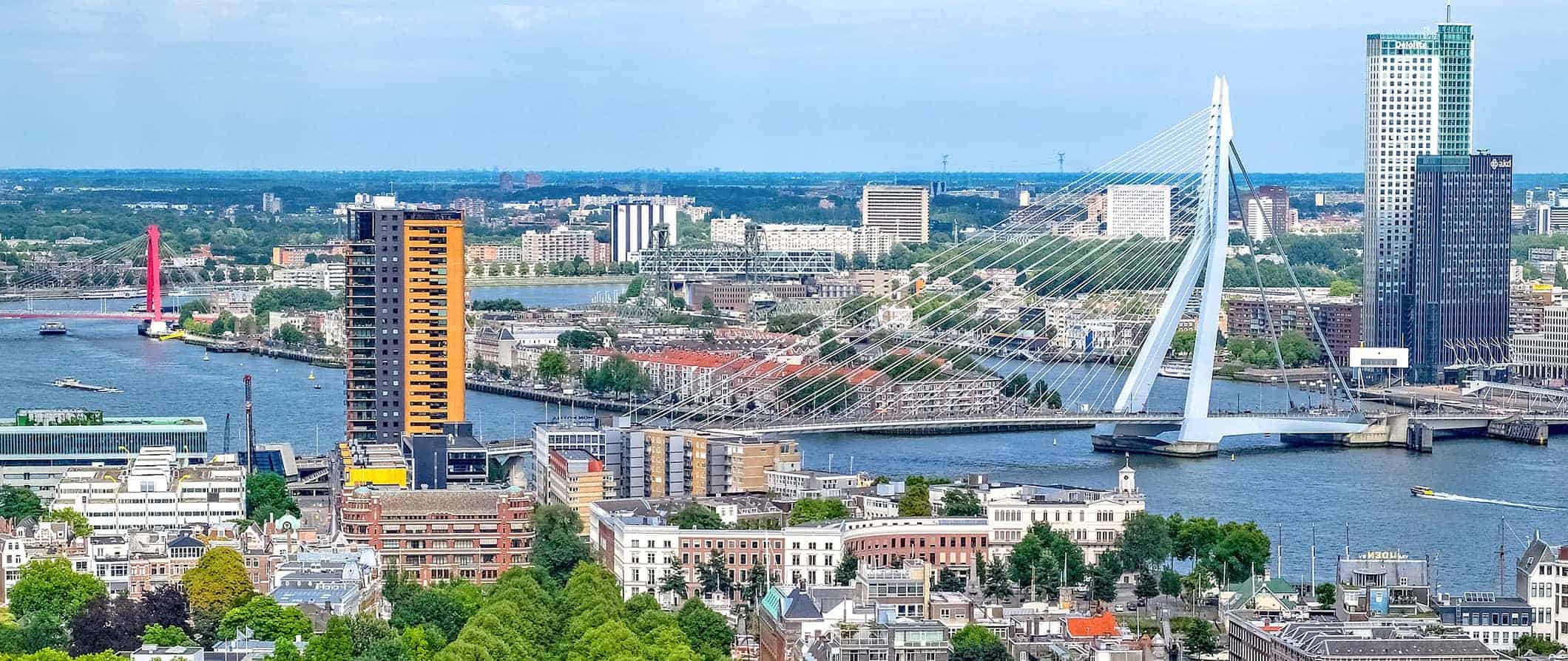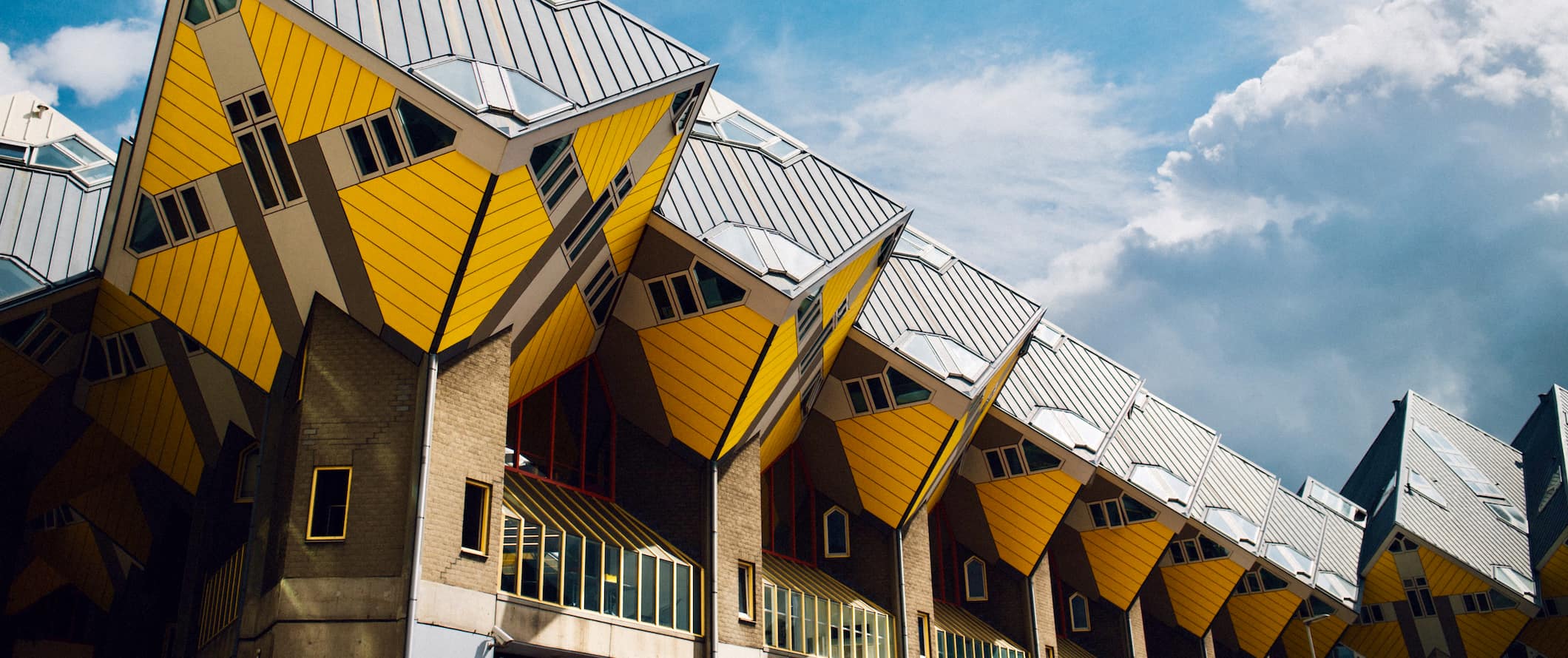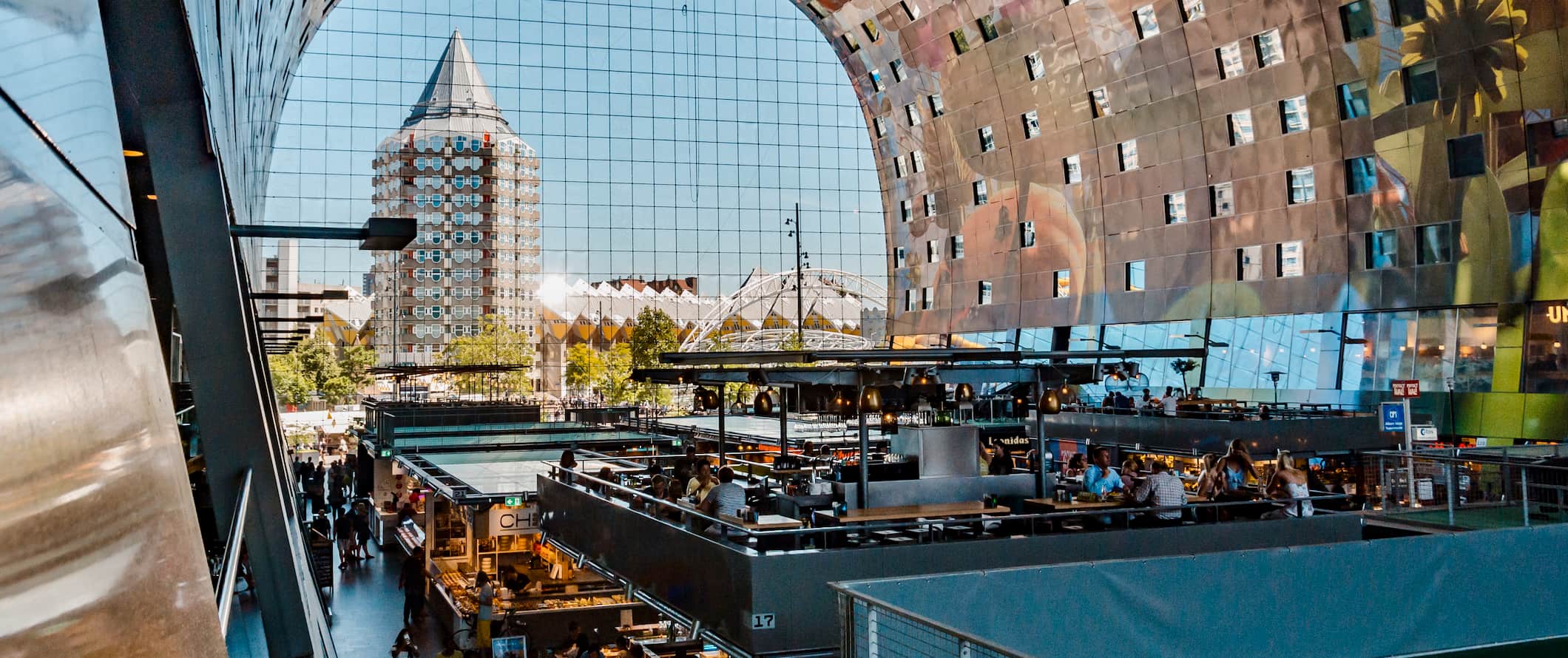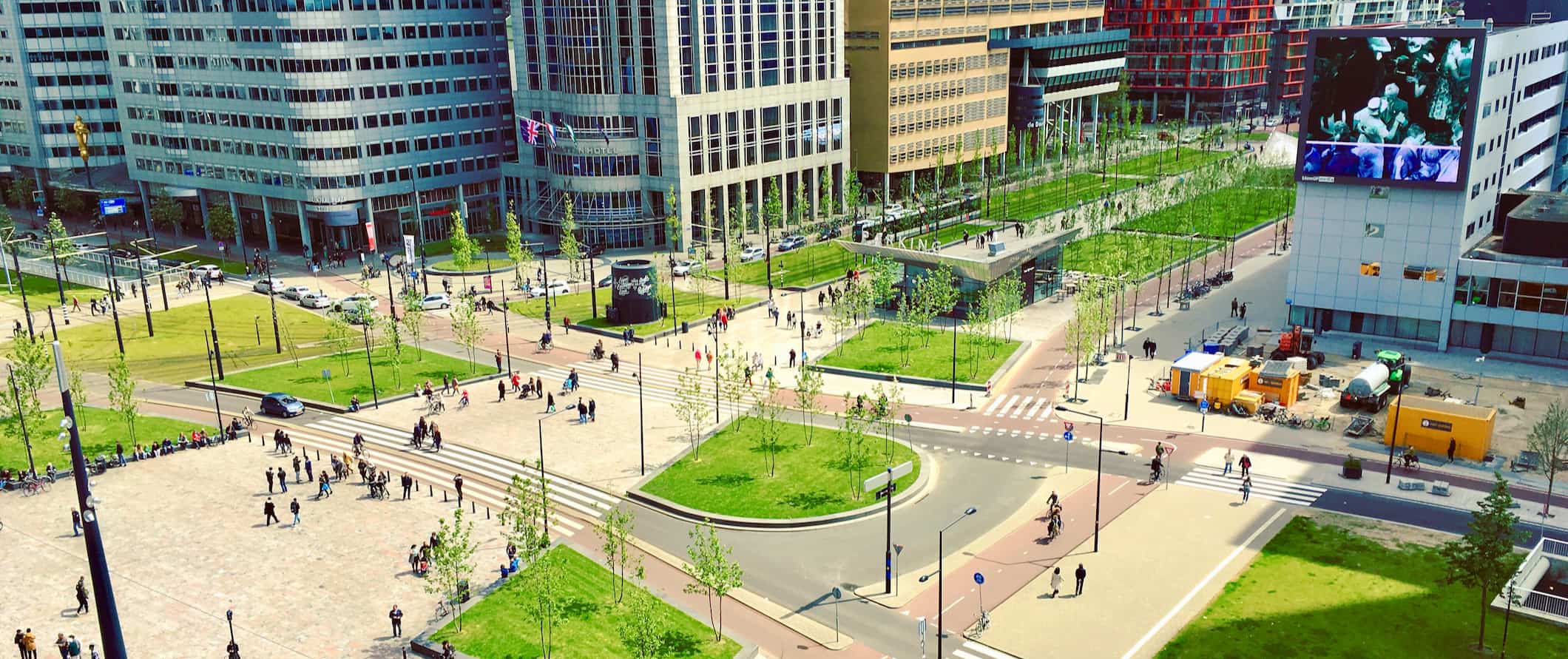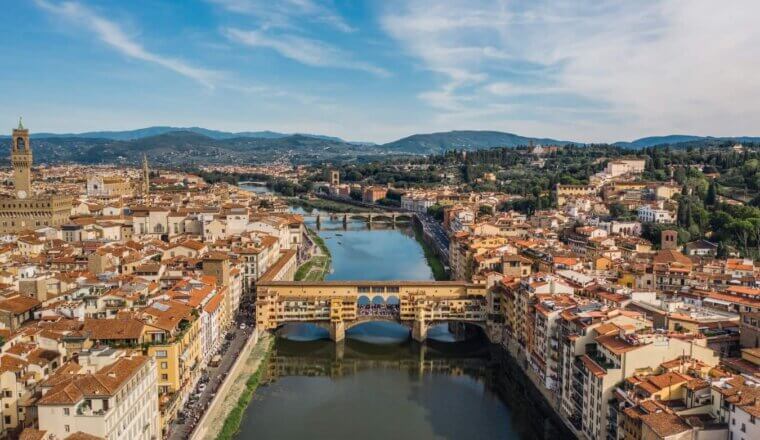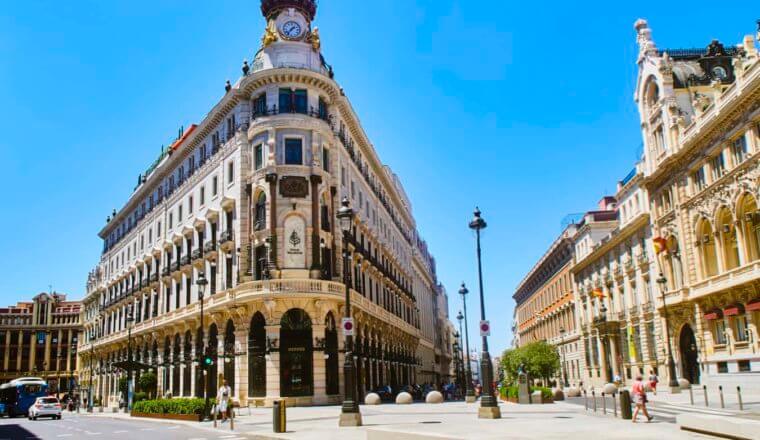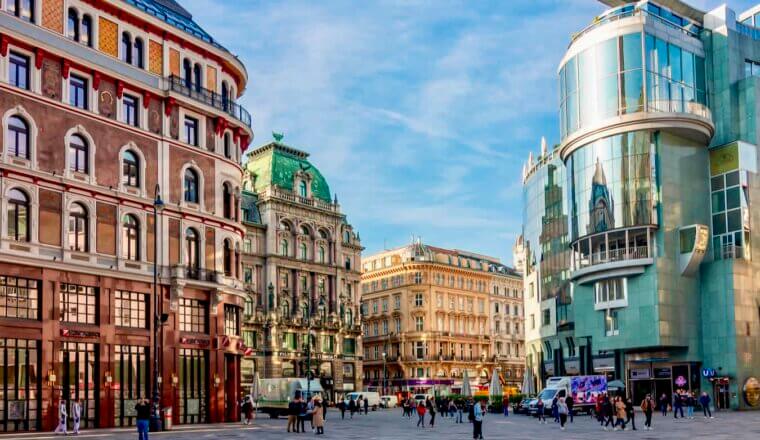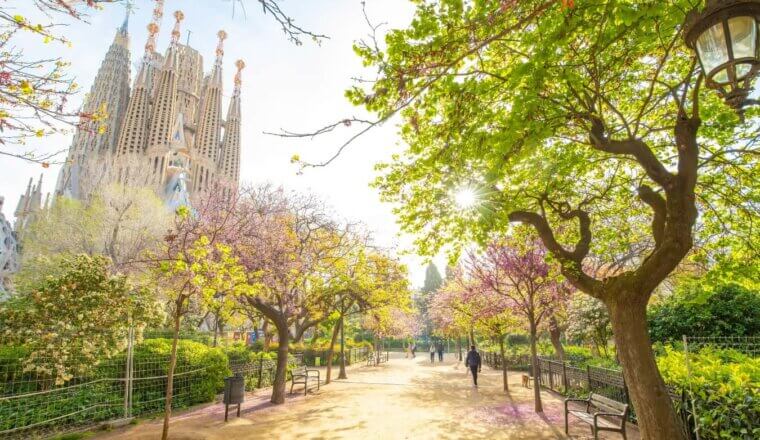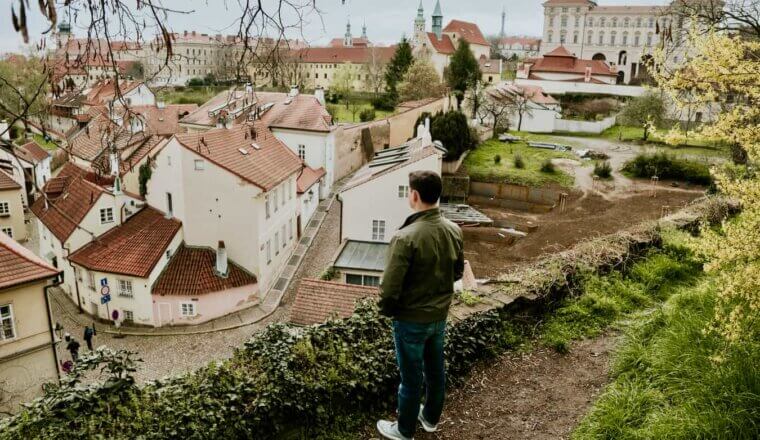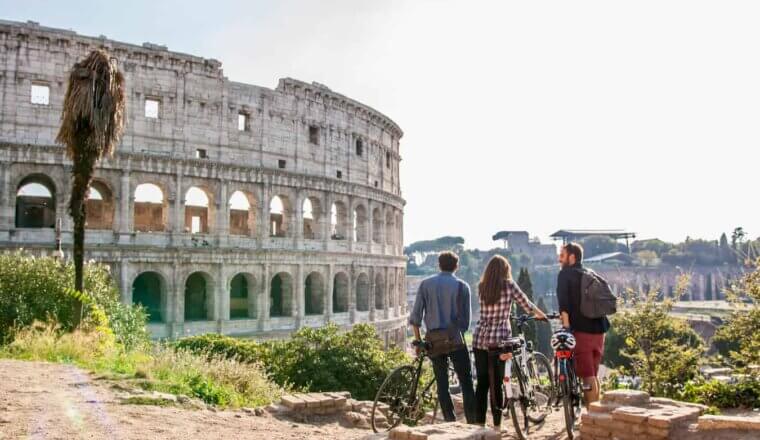Often overshadowed by Amsterdam, Rotterdam is a funky little port town that prides itself on its unique architecture, cool art, amazing food, and massive harbor. The city is one of the most multicultural in the country and hosts an array of festivals and concerts throughout the year.
I really enjoy Rotterdam. It is a laid-back contrast to the wild, canal-lined streets of Amsterdam. Plus, the parks here are plentiful and the city comes to life in the summer with festivals, concerts, and other free events. (But, even while busy, it’s a far cry from the packed streets of Amsterdam.) Over the last few years, Rotterdam has really developed into a bustling up with a growing art and vibrant new restaurant scene.
This Rotterdam travel guide can help you plan your trip to this often overlooked destination.
Table of Contents
Top 5 Things to See and Do in Rotterdam
1. See the Erasmus Bridge
This bridge (nicknamed “The Swan”) resembles a harp and towers over Europe’s largest harbor. Connecting the north and south of Rotterdam over the Nieuwe Maas river, this is a cable-stayed bridge as well as a bascule bridge (aka a drawbridge; the bascule part can be raised to allow large ships to pass under it). From the bridge, you can spot the iconic Cube Houses (more on them below) as well as the Art Nouveau-style Witte Huis. Walk a little further and you can explore the charming Delfshaven neighborhood.
2. Walk the harbor
Rotterdam has the largest and busiest harbor in all of Europe and it stretches out over 40 kilometers (25 miles). Head to Futureland (free admission) to learn more about Maasvlakte 2, the most recent part of the port that opened in 2013. If you’re short on time, just wander around and watch all the boats coming and going or take a stroll through the piers and check out luxurious yachts owned by the world’s elite. I enjoyed eating lunch at the cafes and watching the world go by wondering “where is that ship going?”
3. Go up the Euromast tower
This tower has a rotating elevator that takes you 185 meters (606 feet) in the air. There’s also a restaurant at the top (but it’s a bit expensive). Thanks to the flat landscape of the country, the picturesque views stretch on for miles. If you like adventure, you can actually abseil down from the top! Admission to the viewing platforms is 11.50 EUR but if you want to go all the way to the top, it’s 15.50 EUR. Abseiling (May to September only) is 62.50 EUR.
4. Visit the Cube Houses
Rotterdam is known for its modern, cutting-edge architecture. A great example of this is the quirky Cube Houses, a row of 38 bright yellow, small, cube-shaped houses. The cubes are elevated and supported on hexagonal pylons, freeing space on the ground. Also known as Blaak Forest, they were designed by Dutch architect Piet Blom and built in the 1980s. Most of the houses are private residences but one is open to the public for 3 EUR.
5. Relax in the park
Located right by the river near the Euromast, Het Park is a gigantic park perfect for strolls, picnics, and sports. (Don’t tell the people in Amsterdam, but I enjoyed it more than Amsterdam’s famed Vondelpark.) I highly recommend spending some time here. It was designed in the 1850s to look and feel like a traditional English garden. There are park houses, a mini-golf course (7.50 EUR per round), benches, and a BBQ area. Pack a lunch, bring a book, and lounge the day away.
Other Things to See and Do in Rotterdam
1. Attend the Rotterdam Summer Carnival
Rotterdam has a thriving community of local artists. Their contributions are best reflected in the many festivals that take place in the port city, especially in the summer. The annual Rotterdam Summer Carnival, held the last weekend of July, includes a full lineup of dancing, parties, and colorful parades. It’s the largest street party in the Netherlands with over 2,500 dancers, 25 carnival groups, and 30 floats on display. If possible, try to see the Battle of the Drums at the beginning of the carnival — the streets become filled with Caribbean brass bands all competing for the “Golden Drum” award.
2. Visit the Museum Boijmans Van Beuningen
This museum, founded in 1849, houses a rich collection of masterpieces such as Pieter Bruegel the Elder’s The “Little” Tower of Babel (1563). In addition to a large permanent collection of works by Dutch masters, there’s a broad collection of surrealism, featuring Salvador Dalí and René Magritte. While under renovation (expected to be completed in 2029), many items are accessible at other Rotterdam museums.
3. See City Hall
Built in 1914, the Rotterdam City Hall is one of the few buildings that survived the destruction of World War II (the Netherlands was officially neutral, however, the Nazis carpet-bombed Rotterdam and invaded the country anyway). There are several large statues outside the building, including the touching Memorial to the Fallen featuring four bronze figures meant to commemorate the victims of the war (900 people were killed and 85,000 were left homeless after just one day of bombing). Most of the notable architecture and monuments are on the exterior, but if you’d like a tour inside, you can book one from the local tourist office.
4. Peek in the Oude Kerk
This is another one of the few buildings that survived the World War II destruction. The Old Church, also called the Pilgrim Fathers Church, is one of the major sights in the Delfshaven neighborhood. Although the neighborhood is surrounded by the Red Light District, it’s nevertheless quite peaceful and quiet. The church dates to 1306 and is home to several artifacts, including a huge organ and the tombs of several noteworthy individuals, including Rembrandt’s wife. The church is said to be the site where the Pilgrims last prayed prior to leaving for the Americas. It’s 12 EUR to visit.
5. Do a harbor tour
If you enjoyed wandering the harbor and want to learn more about it, do a harbor tour. The harbor in Rotterdam is one of the largest and busiest in the entire world. Dutch history is inherently intertwined with the sea, so hopping on a boat tour is a great way to view some of the action. You’ll get to soak in the view of the city’s skyline while also viewing the shipyards, docks, and many giant shipping containers. Tours cost 15.75 EUR and last 75 minutes.
6. Visit the Kunsthal Rotterdam
For fans of contemporary art, the Kunsthal Rotterdam museum hosts temporary art exhibitions. While there is no permanent collection at the gallery, the space regularly attracts well-known artists. There is also a nice restaurant and a small garden and grounds to explore. Admission is 16.50 EUR and the museum is open daily when exhibitions are on. Check the website to see what’s on during your visit.
7. Grab a bite to eat at the Markthal
The Markthal is a large indoor market hall. Its impressive exterior is shaped like a horseshoe while the interior boasts over 100 different food stalls and restaurants. There’s also a supermarket and even a free historical exhibition space showcasing archaeological finds discovered during its construction. There’s a large mural of food, flowers, and insects covering the vaulted interior too. It’s a great place to snack and people-watch.
8. Explore the Het Nieuwe Instituut
The Museum for Architecture, Design, and Digital Culture offers a unique take on modern society. With exhibitions focusing on the three themes of design, architecture, and culture, it’s an insightful place to learn more about Rotterdam’s contemporary architecture. The Sonneveld House nearby, built in the modernist Dutch Functionalist style, is part of the museum’s collection and can be visited with the same admission ticket of 14 EUR (free on Thursday evenings).
9. Wander the Rotterdam Zoo
Rotterdam Zoo is one of the Netherlands’ oldest zoos and is considered one of the best zoos in Europe (it opened in 1857). Spanning over 60 acres, visitors can take a tour “around the world” through the various animal exhibitions and see giraffes, polar bears, elephants, and more. There’s also a relaxing botanical garden and an aquarium here as well. Admission is 23.50 EUR.
10. See Grote of Sint-Laurenskerk
This medieval Protestant church is the only remaining late Gothic building in Rotterdam, which was originally a medieval city. During World War II, the church was bombed, leaving only the walls intact. It was one of the few buildings in the city to be restored rather than replaced. There’s a tower that you can climb in spring/summer and three huge organs — including the largest organ in the Netherlands. Admission is 3 EUR and it costs another 7.50 EUR to climb the tower.
11. Tour the Maritime Museum
This museum is the oldest and largest museum in the Netherlands. It’s an immersive experience that covers six centuries of maritime history via its functional historic vessels and cranes. Some of the interactive exhibits include a trip offshore as well as learning about the drug trade (much of the world’s drugs are trafficked by ship). Tickets cost 16 EUR.
12. Explore the SS Rotterdam
The former flagship of the Holland America Line is now not only an attraction offering tours but you can actually sleep on board as well. Between 1959 and 1971, the ship ran transatlantic journeys between Europe and America. After flights put transatlantic boat trips out of business, it transitioned into a five-star cruise liner. It is now moored at the quayside in Rotterdam. There are three tours that you can take (two are guided while one is an audio tour). They last 1-2.5 hours and cost 12.95-16.50 EUR. Staying overnight costs from 80 EUR depending on the time of year.
For more information on other cities in The Netherlands, check out these guides:
Rotterdam Travel Costs
Hostel prices – Hostels start at 27 EUR per night for 12-14-bed dorms and 35 EUR for 4-6-bed dorms. A basic private room with a shared bathroom starts at 65 EUR. Prices don’t change much between peak and off-peak seasons but some hostels close in the off-season.
For those traveling with a tent, camping is available outside the city. A basic plot for one person without electricity costs around 12.50 EUR.
Budget hotel prices – Centrally located two-star hotels begin at 70 EUR per night for a double with a private bathroom and free Wi-Fi. Off-season, prices start at 55 EUR per night for the same type of room. For somewhere really unique, check out Culture Campsite. It features tiny houses using upcycled materials, including calf igloos, beach huts, and old trucks. Prices start at 65 EUR in low season and 75 EUR in high season.
Rotterdam has lots of Airbnb options, although it has become more tightly regulated in recent years. A private room can be as low as 45 EUR per night with a shared bathroom, even in peak season, but they average closer to 70-90 EUR. An entire apartment averages about 140 EUR per night, with off-season prices costing around 100 EUR per night.
Food – Dutch cuisine typically involves lots of vegetables, bread, and cheeses (gouda originated here). Meat, while historically not as prominent, is a staple of dinner meals. Breakfast and lunch usually involve open-faced sandwiches, often with cheeses and cold cuts. Dinners are very much a “meat and potatoes” meal, with meat stews and smoked sausage being two popular choices. For those with a sweet tooth, the stroopwafel (a waffle cookie with a syrup filling) is the go-to choice, though apple tarts/pies are also local favorites.
If you’re on a budget, falafel and shawarma shops are your best bet for cheap food. Meals here cost around 5-10 EUR. Cheap fast food (think fries and burgers) cost around 9 EUR.
Restaurant meals average around 15 EUR for a main dish of more traditional Dutch cuisine. In a mid-range restaurant, a three-course menu with a drink costs at least 30-40 EUR.
Pizza costs around 10-15 EUR while Chinese food is also around 10-15 EUR for a main dish. Beer is 4 EUR while a latte/cappuccino is 3 EUR. Bottled water is 2.40 EUR.
If you cook your meals, expect to pay 60-70 EUR per week for groceries that include pasta, rice, vegetables, and some meat.
Backpacking Rotterdam Suggested Budgets
If you’re backpacking Rotterdam, expect to spend about 65 EUR per day. This budget covers staying in a hostel dorm, limiting your drinking, taking public transit to get around, cooking your meals, and sticking to mostly free activities like walking tours and exploring the market. If you plan on drinking, add 10-20 EUR more per day to your budget.
On a mid-range budget of about 145 EUR per day, you can stay in a private hostel room or Airbnb, enjoy a drink or two, eat out a little bit, take the occasional taxi to get around, and do more paid activities like a harbor tour and visiting some museums.
On a “luxury” budget of 280 EUR or more per day, you can stay in a hotel, eat out for all your meals, drink more, take more taxis and rent a bike to get around, and do whatever tours and activities you want. This is just the ground floor for luxury though. The sky is the limit!
Rotterdam Travel Guide: Money-Saving Tips
The Netherlands is not a cheap destination — and the city of Rotterdam is no exception to that rule. However, there are plenty of ways to save money if you look for them. Here are some tips to help you get started:
- Rent a bicycle – The easiest and cheapest way to get around the city (besides walking) is to rent a bike. Donkey Republic is an app that has locations all over the city. You can get a bike with them for around 3.30 EUR per hour or 10-13 EUR per day.
- Eat cheap – Rotterdam has a lot of cheap snack and falafel shops that cost 5-10 EUR. Additionally, buying food at the market is a great way to stock up on groceries for the week. It’s not glamorous, but it’s cheap.
- Get the Welcome Card – If you plan to do a lot of sightseeing, get this city tourist card. It offers discounts on most attractions (and some are free) as well as three days’ worth of travel on the train and bus system. It’s a bargain if you are going to stay in the city for a while and see a lot. The 24-hour pass is just 13.50 EUR.
- Stay with a local – Couchsurfing is a service that lets travelers stay with locals for free. You’ll get to connect with a local who can share their insider tips and advice, making this an amazing platform to use to get travel tips. Just be sure to send your requests early as there are not many hosts here.
- Get the Museumkaart (Museum Card) – Good for one month for non-residents, this card gets you into museums in the Netherlands for only 64.90 EUR. With the Museum Card, you get access to more than 400 museums throughout the Netherlands (the temporary card available to tourists can only be used at a maximum of 5 different museums, however). Depending on your trip, though, it can save you money if you choose your museums wisely.
- Buy the Rotterdam Pass – The Rotterdam Pass is valid for a year so if you’re planning to spend a long time in Rotterdam, or you’re going to be making multiple visits there, then it definitely makes sense to pick one up. It provides free admission or discounts at around 500 attractions in and around Rotterdam including 20 museums and some food outlets so if you’re planning to eat out and see lots of attractions then it’s worth it. It costs 60 EUR.
- Take a free walking tour – If you want an overview of the city, take a free walking tour with Free Walking Tour Rotterdam. They offer insightful tours that can help you learn about the city on a budget. Just be sure to tip!
- Save money on rideshares – Uber is cheaper than taxis here and is the best way to get around a city if you don’t want to wait for a bus or pay for a taxi.
- Bring a water bottle – The tap water here is safe to drink so bring a reusable water bottle to save money and reduce your plastic use. LifeStraw is my go-to brand as their bottles have built-in filters to ensure your water is always clean and safe.
Where to Stay in Rotterdam
Rotterdam doesn’t have many hostel options but there are still a handful of budget-friendly accommodations to choose from. Here are some of my favorite places to stay in Rotterdam:
How to Get Around Rotterdam
Public transportation – Rotterdam has an extensive public transport system of buses, trams, and a metro run by RET. A single journey up to 2 hours is 4.50 EUR so it’s a lot cheaper to buy a day pass for 9.50 EUR if you’re moving around a lot. If you need a 2- or 3-day pass, it’s cheaper to buy the multi-day Rotterdam Welcome Card.
Note: Cash is not accepted on public transportation. You need to purchase an OV chip card to ride. They come in reloadable and non-reloadable versions.
Bicycle – Like other cities in the Netherlands, cycling is one of the most popular ways to get around. Donkey Republic has stations all over the city with prices starting at 3.30 EUR per hour and 10-13 EUR per day.
Taxi – It’s probably not necessary to take taxis to get around Rotterdam as bikes, walking, and public transport can get you anywhere you need to go. However, if you do need a ride, prices start at 4 EUR and go up 2 EUR per kilometer. Skip them if you can as those prices add up fast!
Ridesharing – Uber is available in Rotterdam but, again, public transportation goes everywhere so skip them if you can.
Car rental – Car rentals begin at 25 EUR per day for a multi-day rental. However, you won’t need a car unless you’re planning to leave the city and explore the region. For the best car rental prices, use Discover Cars.
When to Go to Rotterdam
Rotterdam’s peak season is July-August. This is when the city is liveliest and when you’ll find most of the festivals and events. It’s also when the city is busiest so be sure to book your accommodation early since there are not a ton of hostels here. The average daily summer temperature in Rotterdam is around 22°C (72°F), but it can get a lot hotter than that during July and August.
The weather is mild during the off-season (late spring and early fall) and prices are a little cheaper. If you’re on a tight budget, this is a good time to visit.
The average daily temperature in the winter is 7°C (45°F) so dress warmly if you visit during that time. Generally, I would say avoid visiting in the winter unless you come around Christmas as the city lights up with holiday markets and festivities.
How to Stay Safe in Rotterdam
Rotterdam is an incredibly safe place to backpack and travel. Violent crime is very rare here. Pick-pocketing, while uncommon, can still occur though so keep an eye on your belongings when on crowded public transit.
Solo female travelers should generally feel safe here, however, the standard precautions apply (never leave your drink unattended at the bar, never walk home alone intoxicated, etc.).
There are a few common scams to be aware of here, such as people trying to sell you public transit tickets that actually have already been used. Also, be wary of purchasing a really cheap bike from someone off the street as it has likely been stolen. Overall, scams here are rare but you can read about common travel scams to avoid.
If you experience an emergency, dial 112 for assistance.
The most important piece of advice I can offer is to purchase good travel insurance. Travel insurance protects you against illness, injury, theft, and cancellations. It’s comprehensive protection in case anything goes wrong. I never go on a trip without it as I’ve had to use it many times in the past. You can use the widget below to find the policy right for you:
Rotterdam Travel Guide: The Best Booking Resources
These are my favorite companies to use when I travel. They consistently have the best deals, offer world-class customer service and great value, and overall, are better than their competitors. They are the companies I use the most and are always the starting point in my search for travel deals.
- Skyscanner – Skyscanner is my favorite flight search engine. They search small websites and budget airlines that larger search sites tend to miss. They are hands down the number one place to start.
- Hostelworld – This is the best hostel accommodation site out there with the largest inventory, best search interface, and widest availability.
- Booking.com – The best all around booking site that constantly provides the cheapest and lowest rates. They have the widest selection of budget accommodation. In all my tests, they’ve always had the cheapest rates out of all the booking websites.
- HostelPass – This new card gives you up to 20% off hostels throughout Europe. It’s a great way to save money. They’re constantly adding new hostels too. I’ve always wanted something like this and glad it finallt exists.
- Get Your Guide – Get Your Guide is a huge online marketplace for tours and excursions. They have tons of tour options available in cities all around the world, including everything from cooking classes, walking tours, street art lessons, and more!
- The Man in Seat 61 – This website is the ultimate guide to train travel anywhere in the world. They have the most comprehensive information on routes, times, prices, and train conditions. If you are planning a long train journey or some epic train trip, consult this site.
- Trainline – When you’re ready to book your train tickets, use this site. It streamlines the process of booking trains around Europe.
- Rome2Rio – This website allows you to see how to get from point A to point B the best and cheapest way possible. It will give you all the bus, train, plane, or boat routes that can get you there as well as how much they cost.
- FlixBus – Flixbus has routes between 20 European countries with prices starting as low 5 EUR! Their buses include WiFi, electrical outlets, a free checked bag.
- SafetyWing – Safety Wing offers convenient and affordable plans tailored to digital nomads and long-term travelers. They have cheap monthly plans, great customer service, and an easy-to-use claims process that makes it perfect for those on the road.
- LifeStraw – My go-to company for reusable water bottles with built-in filters so you can ensure your drinking water is always clean and safe.
- Unbound Merino – They make lightweight, durable, easy-to-clean travel clothing.
- Top Travel Credit Cards – Points are the best way to cut down travel expenses. Here’s my favorite point earning credit cards so you can get free travel!
- BlaBlaCar – BlaBlaCar is a ridesharing website that lets you share rides with vetted local drivers by pitching in for gas. You simply request a seat, they approve, and off you go! It’s a cheaper and more interesting way to travel than by bus or train!
Rotterdam Travel Guide: Related Articles
Want more info? Check out all the articles I’ve written on backpacking/traveling Europe and continue planning your trip:
